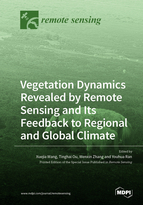Vegetation Dynamics Revealed by Remote Sensing and Its Feedback to Regional and Global Climate
A special issue of Remote Sensing (ISSN 2072-4292). This special issue belongs to the section "Remote Sensing in Agriculture and Vegetation".
Deadline for manuscript submissions: closed (31 May 2022) | Viewed by 26572
Special Issue Editors
Interests: vegetation change; land–atmosphere interactions; model simulation; climate change
Special Issues, Collections and Topics in MDPI journals
Interests: climate extreme events; land–atmosphere interaction; climate modeling
Special Issues, Collections and Topics in MDPI journals
Interests: soil thermal regime; vegetation dynamics; biophysical properties of vegetaton; land surface models
Special Issues, Collections and Topics in MDPI journals
Interests: remote sensing and modeling of the frozen ground and environment; climate change
Special Issues, Collections and Topics in MDPI journals
Special Issue Information
Dear Colleagues,
Vegetation, as one of the crucial underlying land surfaces, plays an important role in terrestrial ecosystems and the Earth's climate system. Under the impact of climate warming, vegetation exhibits clear diverse responses, such as greening and browning, which have been reported by many remote sensing studies. Vegetation is an important and sensitive indicator of climate and environment evolutions, underscoring the need to better detect and understand vegetation physiological and phenological responses, analyze mechanims of how changes in land surface properties (e.g. surface albedo and roughness length) are associated with vegetation dynamics, and identify climate and ecological feedbacks of vegetation changes. The recent development of satellite remote sensing and its derived products provide great opportunities to study vegetation dynamics and its feedback to regional and global climate system. Moreover, some of the new generation of climate models, such as CMIP6 Earth system models, which include dynamic vegetation, are state-of-the-art tools for investigating the feedback of vegetation changes.
For this Special Issue, contributions are sought which demonstrate the application of a variety of high-resolution satellite data, global and regional numerical models, and machine learning methods to obtain the fine classification of vegetation, detect vegetation dynamic changes, and examine interactions between vegetation and climate/ecological systems, especially for high-latitude and high-altitude regions. We would like to invite you to contribute to the Special Issue. Submissions are encouraged to cover a wide range of topics, which may include, but are not limited to, the following:
- Vegetation mapping;
- Vegetation changes from various remote sensing data sources;
- Response of vegetation to climate change;
- Feedback of vegetation change to climate;
- Dynamic vegetation modeling;
- Ecological effect of vegetation change.
Dr. Xuejia Wang
Dr. Tinghai Ou
Dr. Wenxin Zhang
Dr. Youhua Ran
Guest Editors
Manuscript Submission Information
Manuscripts should be submitted online at www.mdpi.com by registering and logging in to this website. Once you are registered, click here to go to the submission form. Manuscripts can be submitted until the deadline. All submissions that pass pre-check are peer-reviewed. Accepted papers will be published continuously in the journal (as soon as accepted) and will be listed together on the special issue website. Research articles, review articles as well as short communications are invited. For planned papers, a title and short abstract (about 100 words) can be sent to the Editorial Office for announcement on this website.
Submitted manuscripts should not have been published previously, nor be under consideration for publication elsewhere (except conference proceedings papers). All manuscripts are thoroughly refereed through a single-blind peer-review process. A guide for authors and other relevant information for submission of manuscripts is available on the Instructions for Authors page. Remote Sensing is an international peer-reviewed open access semimonthly journal published by MDPI.
Please visit the Instructions for Authors page before submitting a manuscript. The Article Processing Charge (APC) for publication in this open access journal is 2700 CHF (Swiss Francs). Submitted papers should be well formatted and use good English. Authors may use MDPI's English editing service prior to publication or during author revisions.
Keywords
- vegetation type
- vegetation phenology
- change detection
- model simulation
- response to climate change
- feedback to climate change









